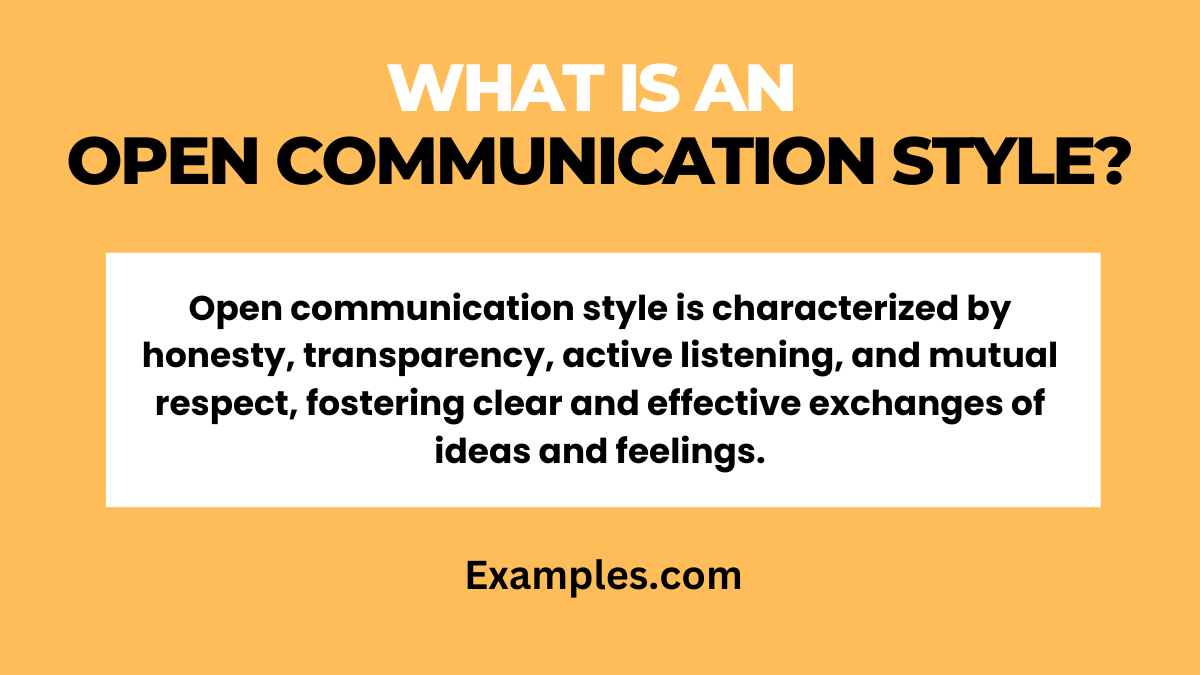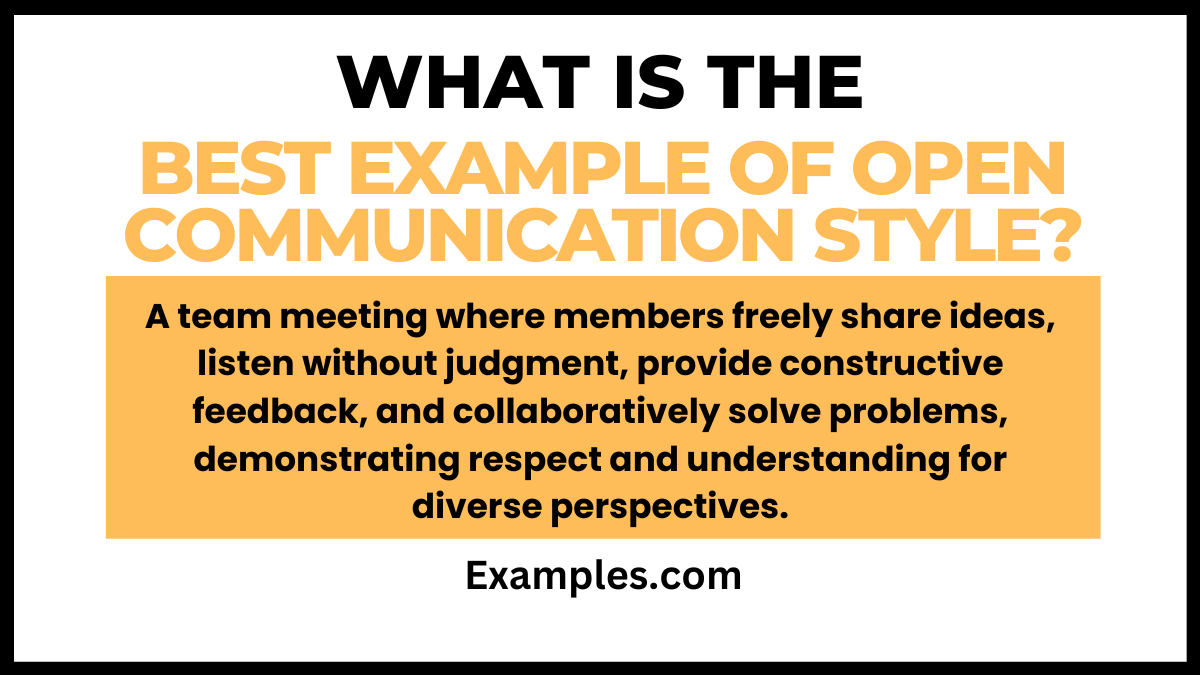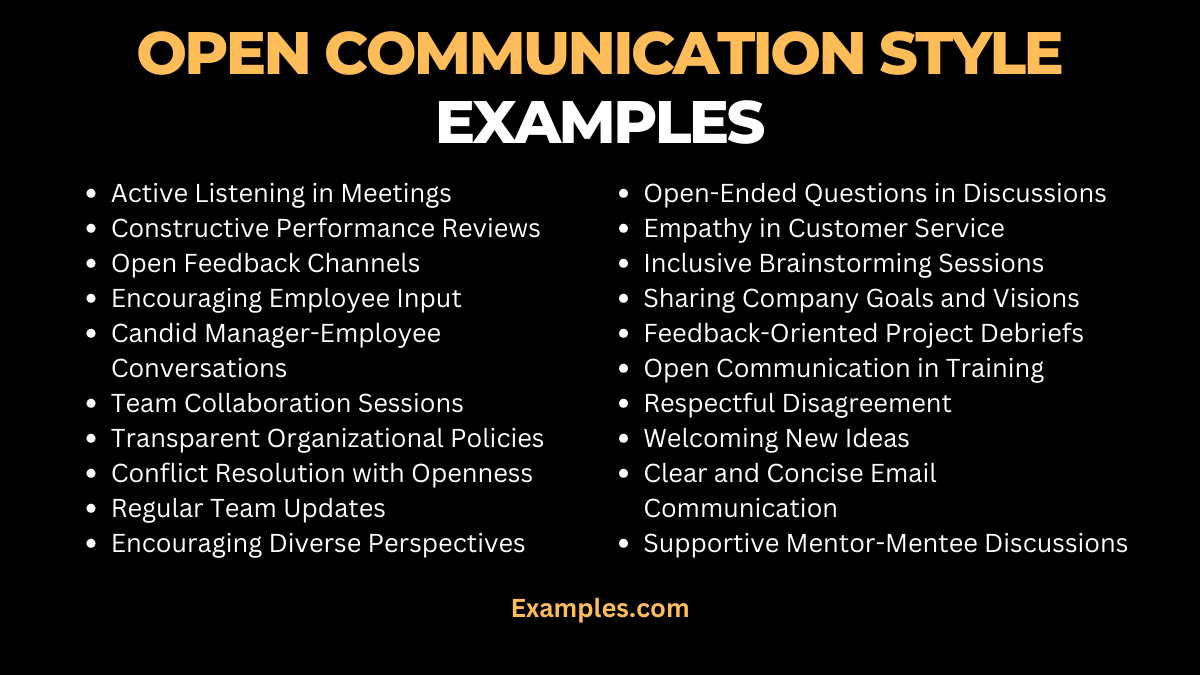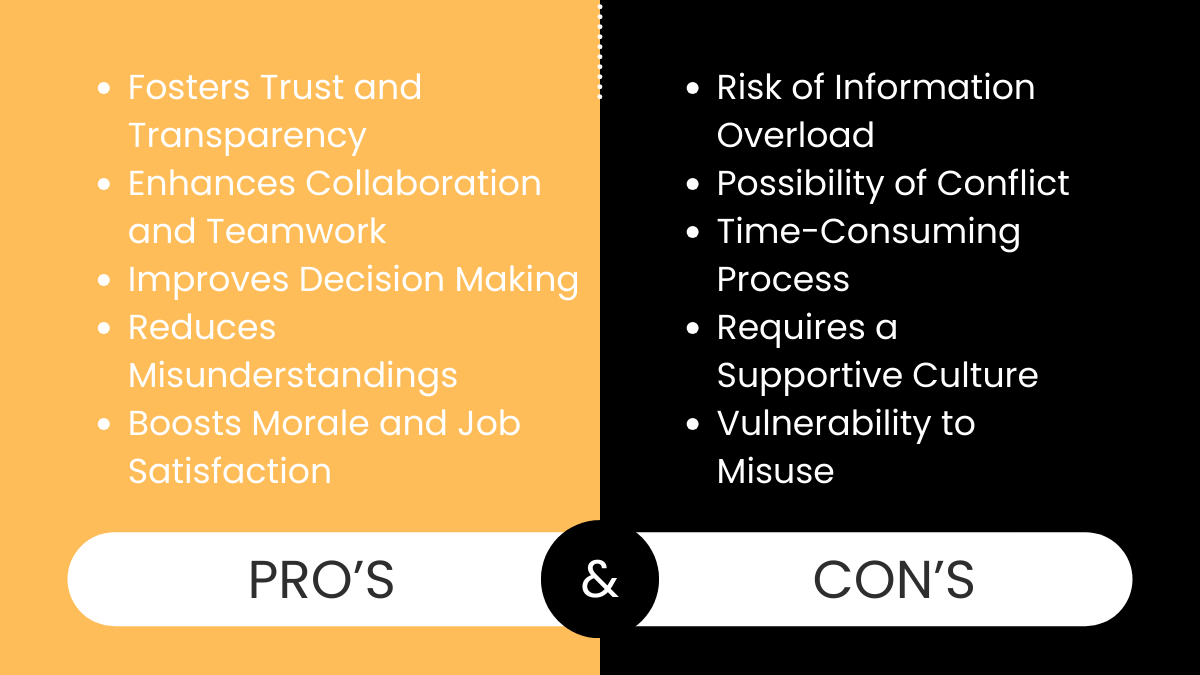19+ Open Communication Style Examples
Open Communication Style is a pivotal element in fostering healthy interactions across various settings. This complete guide delves into the nuances of open communication, providing practical and relatable communication examples to illustrate its effectiveness. By exploring the core principles and real-life applications, readers will gain a comprehensive understanding of how open communication can transform relationships, enhance workplace dynamics, and lead to more meaningful connections. Embracing this style paves the way for transparency and mutual understanding in all forms of interaction.
Download Open Communication Style in PDFWhat is an Open Communication Style? – Definition

An Open Communication Style is a way of interacting where individuals freely and honestly express their thoughts, feelings, and opinions. It’s marked by a willingness to share information, listen actively, and engage in transparent dialogue. This style encourages a straightforward and clear exchange of ideas, where both parties feel respected and heard. Open communication is key to building trust and understanding in any relationship, be it personal or professional. It fosters a positive environment where ideas flow openly, leading to enhanced collaboration and stronger connections.
What is the Best Example of Open Communication Style?

In a vibrant workplace scenario, the best example of an open communication style is observed during team meetings where leaders encourage communication in the workplace. This approach involves actively inviting team members to express their opinions and ideas, fostering a culture of transparency and inclusivity. Such an environment not only enhances team collaboration but also significantly contributes to a positive and productive work atmosphere, exemplifying the profound impact of open communication in professional settings.
20 Open Communication Style Examples

Open communication style is essential in nurturing effective communication, especially in communication in the workplace and personal relationships. This guide provides 20 distinct examples, each illustrating how open and transparent communication can lead to better understanding, stronger connections, and enhanced collaboration. These examples, complete with practical explanations and sentences, offer insights into implementing open communication in various scenarios, from professional settings to personal interactions.
- Active Listening in Meetings
Fostering an environment where everyone’s opinions are valued.
Example: “I want to understand your point of view; could you please elaborate more?” - Constructive Performance Reviews
Balancing positive reinforcement with constructive feedback.
Example: “Your contribution to the project was significant; let’s explore areas for further growth.” - Open Feedback Channels
Encouraging a culture of sharing ideas and feedback.
Example: “Your suggestions are important to us; please feel free to share.” - Encouraging Employee Input
Valuing employee contributions in decision-making.
Example: “We’re considering several approaches; what are your thoughts?” - Candid Manager-Employee Conversations
Promoting honest and open discussions about career growth.
Example: “Let’s discuss your career path and how we can support your goals.” - Team Collaboration Sessions
Encouraging collective problem-solving and idea-sharing.
Example: “Let’s brainstorm together to find the best solution.” - Transparent Organizational Policies
Ensuring clarity and understanding of company policies.
Example: “We aim to be clear about our policies; does anyone need further clarification?” - Conflict Resolution with Openness
Addressing conflicts directly and respectfully.
Example: “I understand we have differing opinions; let’s find a common solution.” - Regular Team Updates
Maintaining open lines of communication about team progress.
Example: “Here’s an update on our project status; let’s discuss the next steps.” - Encouraging Diverse Perspectives
Welcoming different viewpoints for richer discussions.
Example: “Your diverse perspectives help us tackle challenges more creatively.” - Open-Ended Questions in Discussions
Stimulating deeper thinking and exploration.
Example: “How do you think we can improve our approach to this project?” - Empathy in Customer Service
Understanding and addressing customer needs effectively.
Example: “I understand your concerns; let’s work together to resolve this.” - Inclusive Brainstorming Sessions
Creating a space where all ideas are heard and considered.
Example: “All ideas are valuable; let’s explore each one.” - Sharing Company Goals and Visions
Communicating organizational objectives clearly to all team members.
Example: “These are our objectives for the year; let’s align our efforts to achieve them.” - Feedback-Oriented Project Debriefs
Reviewing outcomes and learning for future improvement.
Example: “What did we learn from this project that we can apply moving forward?” - Open Communication in Training
Encouraging active participation and clarity during training sessions.
Example: “Please feel free to ask questions to ensure clear understanding.” - Respectful Disagreement
Expressing differing opinions in a constructive manner.
Example: “I have a different perspective; let me explain my reasoning.” - Welcoming New Ideas
Fostering a culture where innovation is encouraged.
Example: “New ideas are crucial for our growth; what are your suggestions?” - Clear and Concise Email Communication
Ensuring effective communication in written form.
Example: “I’ve outlined the main points; let me know if further clarification is needed.” - Supportive Mentor-Mentee Discussions
Providing guidance and support in a mentoring relationship.
Example: “Let’s discuss how I can best support your professional development.”
These examples of open communication style underscore its importance in fostering a culture of transparency, respect, and collaborative growth in both professional and personal contexts.
Open Communication Style in the Workplace
In today’s dynamic work environment, embracing an open communication style in the workplace is key to fostering teamwork, innovation, and employee satisfaction. This style enhances collaboration and problem-solving, leading to a more productive and harmonious workplace. Here are 10 unique examples of how to implement open communication in professional settings, each with a brief explanation and a communication sentence example.
- Regular Open Forums for Employees
Creating a platform for employees to voice concerns and ideas.
Example: “Let’s use this forum to openly discuss any workplace challenges.” - Leadership Transparency in Strategy Discussions
Leaders openly sharing company strategies and goals.
Example: “Our strategy for this quarter is X; let’s discuss how we can achieve it together.” - Cross-Departmental Communication Initiatives
Encouraging interaction between different departments for better understanding.
Example: “Let’s schedule a meeting with the marketing team to align our objectives.” - Acknowledging and Celebrating Achievements
Recognizing team and individual accomplishments openly.
Example: “Congratulations to the team for achieving this milestone; your efforts are appreciated.” - Open Feedback Culture Post-Project Completion
Discussing what worked well and what can be improved after project completion.
Example: “Let’s review our project outcomes and discuss how we can improve next time.” - Incorporating Employee Suggestions into Decision Making
Valuing and acting on employee suggestions.
Example: “Based on your suggestions, we have updated our approach to X.” - Transparent Communication During Organizational Changes
Openly communicating about changes and their impact on the team.
Example: “We are undergoing some changes; here’s how it will affect our department.” - Facilitating Open Dialogues on Workplace Wellness
Prioritizing discussions on employee well-being and mental health.
Example: “Let’s openly discuss how we can support your wellness at work.” - Encouraging Open Conversations on Career Progression
Managers discussing career paths and growth opportunities with employees.
Example: “Let’s talk about your career aspirations and how we can help you achieve them.” - Creating a Safe Space for Diverse Opinions
Ensuring a respectful environment where diverse opinions are welcomed.
Example: “All viewpoints are important; let’s hear your perspective on this issue.”
Open Communication Style in Business
Open communication in business is pivotal for building strong client relationships, effective team management, and driving growth. A transparent communication approach leads to better decision-making, increased trust, and enhanced customer satisfaction. Below are 10 examples showcasing how open communication can be effectively used in business, complete with explanations and examples of how to communicate these concepts.
- Transparent Client Communications
Building trust with clients through honesty and clarity.
Example: “We believe in transparent communication; here’s the status of your project.” - Open Dialogues on Business Challenges
Discussing business challenges openly with stakeholders.
Example: “We are facing some challenges, but here’s our plan to overcome them.” - Regular Updates to Investors
Keeping investors informed about business progress and setbacks.
Example: “Our quarterly update shows progress in X areas and challenges in Y.” - Employee Involvement in Business Planning
Involving employees in shaping business strategies.
Example: “Your insights are valuable in our business planning process.” - Open Communication on Product Development
Sharing the development process with customers and stakeholders.
Example: “We’re currently developing X and would love your feedback.” - Addressing Customer Feedback Publicly
Responding to customer feedback openly and constructively.
Example: “Thank you for your feedback; we’re taking the following steps to improve.” - Cultivating Open Supplier Relationships
Maintaining honest and collaborative relationships with suppliers.
Example: “Let’s discuss how we can work together more effectively.” - Transparent Marketing Strategies
Communicating marketing strategies openly within the team.
Example: “Our marketing strategy focuses on X; let’s explore its potential together.” - Open Negotiations with Partners
Fostering a transparent and fair negotiation process.
Example: “We believe in fair negotiations; let’s find a mutually beneficial agreement.” - Honest Communication in Crisis Management
Addressing crises with honesty and proactive measures.
Example: “In light of the crisis, here’s our plan to manage and mitigate the impact.”
These examples in both the workplace and business contexts highlight how open communication is instrumental in creating an environment of trust, collaboration, and mutual respect, ultimately leading to greater success and satisfaction.
Importance of Open Communication Style
In the diverse spectrum of communication styles, the importance of open communication style stands out, particularly when contrasted with the manipulative communication style. Open communication is characterized by honesty, clarity, and respect, fostering an environment where ideas and feelings can be shared freely without fear of judgment. This style is instrumental in building trust, a cornerstone in both personal and professional relationships. Unlike manipulative communication, which often leads to misunderstandings and mistrust, open communication ensures that all parties involved have a clear, honest understanding of each other’s intentions and messages. This clarity is crucial in avoiding conflicts and nurturing a healthy, collaborative atmosphere.
Benefits of Using an Open Communication Style
The advantages of adopting an open communication style are multifaceted and significant, especially when compared to the drawbacks of a manipulative approach. One of the primary benefits is the creation of a trusting and transparent environment. In such a setting, individuals feel valued and heard, leading to stronger, more meaningful relationships.
Enhancing Team Collaboration and Morale
In the workplace, open communication plays a pivotal role in boosting team collaboration and morale. Employees who feel that their voices are heard are more engaged and motivated, contributing positively to the team’s dynamics and the organization’s overall success.
Facilitating Clear and Effective Decision-Making
Open communication also aids in clear and effective decision-making. When information is shared openly and inputs from various stakeholders are considered, decisions made are well-informed and more likely to be supported by the entire team.
Encouraging Innovation and Problem-Solving
Another significant benefit is the encouragement of innovation and problem-solving. Open communication fosters an environment where creative ideas and solutions can be discussed without fear of judgment, leading to innovative outcomes and continuous improvement.
Building Strong Customer Relationships
In business, open communication helps in building strong and lasting relationships with customers. By communicating honestly and transparently, businesses can establish trust with their customers, which is essential for long-term success.
Reducing Conflicts and Misunderstandings
Moreover, open communication is key in reducing conflicts and misunderstandings. It ensures that all parties have a mutual understanding, which is crucial in resolving disputes amicably and maintaining harmonious relationships.
The shift from a manipulative communication style to an open one can have profound benefits. It creates a more positive, productive, and harmonious environment, conducive to personal growth and professional success.
Pros and Cons of Open Communication Style

Adopting an open communication style comes with its set of advantages and challenges. Understanding these can help individuals and organizations effectively implement and manage this communication approach.
| Pros of Open Communication Style | Cons of Open Communication Style |
|---|---|
| Fosters Trust and Transparency: Open communication establishes a foundation of trust, ensuring clarity and honesty in interactions, vital for strong relationships. | Risk of Information Overload: The abundance of open dialogue can sometimes lead to an overwhelming amount of information, making it challenging to prioritize. |
| Enhances Collaboration and Teamwork: Encourages sharing ideas and opinions, leading to effective teamwork and innovative solutions. | Possibility of Conflict: Open discussions can bring contrasting opinions to the surface, potentially leading to disagreements and conflicts. |
| Improves Decision Making: Inclusive and democratic, open communication allows diverse viewpoints, leading to more comprehensive and well-informed decisions. | Time-Consuming Process: Thorough discussions and consideration of multiple perspectives can be lengthy, posing challenges in fast-paced decision-making environments. |
| Reduces Misunderstandings: Clear communication minimizes the chances of misinterpretation, ensuring messages are conveyed and received as intended. | Requires a Supportive Culture: Effective open communication needs an organizational culture that values and encourages openness, which can be difficult to cultivate. |
| Boosts Morale and Job Satisfaction: Employees feel valued and heard, leading to increased engagement, job satisfaction, and productivity. | Vulnerability to Misuse: Open communication can sometimes lead to sharing sensitive or inappropriate information, necessitating clear guidelines on communication boundaries. |
Pros of Open Communication Style
Fosters Trust and Transparency
One of the most significant benefits of open communication is the establishment of trust and transparency. In environments where open communication is practiced, individuals are more likely to feel confident in expressing their ideas and concerns, knowing that their contributions will be respected and valued.
Enhances Collaboration and Teamwork
Open communication encourages collaboration and teamwork. When team members openly share information and ideas, it leads to more effective problem-solving, creative thinking, and a more cohesive team dynamic.
Improves Decision Making
With open communication, decision-making processes become more inclusive and democratic. Everyone has the opportunity to contribute their perspectives, leading to well-rounded decisions that take into account various viewpoints.
Reduces Misunderstandings
Clear and direct communication minimizes the chances of misunderstandings and misconceptions. Open communication ensures that messages are conveyed and received as intended, reducing the likelihood of conflicts arising from miscommunication examples.
Boosts Morale and Job Satisfaction
When employees feel that their voices are heard and their opinions matter, it positively impacts their job satisfaction and morale. This can lead to increased employee engagement and productivity.
Cons of Open Communication Style
Risk of Information Overload
One potential downside of open communication is the risk of information overload. With a continuous flow of open dialogue, it can sometimes be challenging to discern critical information from less important details.
Possibility of Conflict
While open communication can reduce misunderstandings, it can also lead to conflicts if not managed properly. Open discussions might bring differing opinions to the forefront, leading to disagreements.
Time-Consuming Process
Open communication often requires more time than other styles, as it involves thorough discussions and the consideration of multiple viewpoints. This can be challenging in fast-paced environments where quick decisions are necessary.
Requires a Supportive Culture
For open communication to be effective, it must be supported by an organizational culture that values and encourages openness. Without this, implementing an open communication style can be challenging.
Vulnerability to Misuse
In some cases, open communication can be misused, leading to the sharing of sensitive or inappropriate information. This risk necessitates clear guidelines on what should and should not be communicated openly.
While the open communication style has numerous benefits, including fostering trust, enhancing collaboration, and improving decision-making, it also comes with challenges like the potential for information overload, time constraints, and the need for a supportive culture. Balancing these pros and cons is key to successfully leveraging open communication in both personal and professional contexts.
What is a Closed Communication Style?
A closed communication style involves restricted information flow, lacking transparency and open dialogue, often leading to misunderstandings and a lack of trust.
What is an Open Line of Communication?
An open line of communication refers to an environment where information flows freely and transparently, encouraging honest dialogue and active listening.
Why is Open Communication Important in School?
Open communication in school fosters a supportive learning environment, enhances student-teacher relationships, and encourages collaborative learning and problem-solving.
The study, The Importance of Establishing Reliability and Validity in Survey Research, published in the Journal of Hospital Medicine, emphasizes the critical role of reliability and validity in survey research for ensuring accurate and trustworthy results. It outlines methodologies for establishing these key aspects in research surveys.
The open communication style is pivotal for fostering transparent, honest, and effective interactions across various spheres. By encouraging free information flow, active listening, and mutual respect, it enhances relationships, decision-making, and conflict resolution. Embracing open communication, whether in personal, educational, or professional settings, leads to more harmonious, productive, and understanding environments, integral for collective growth and success.



